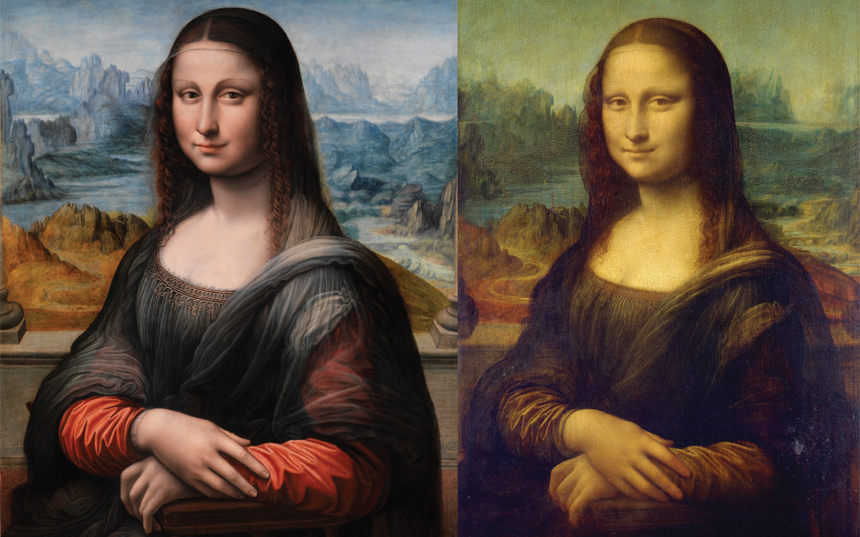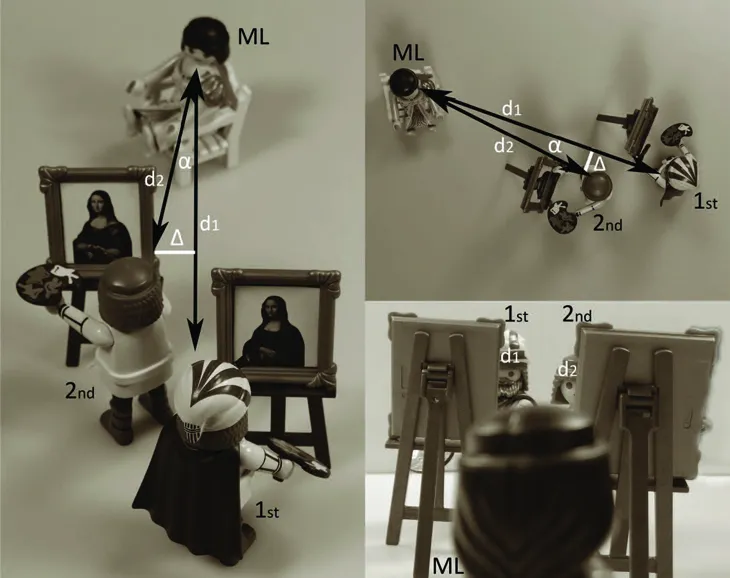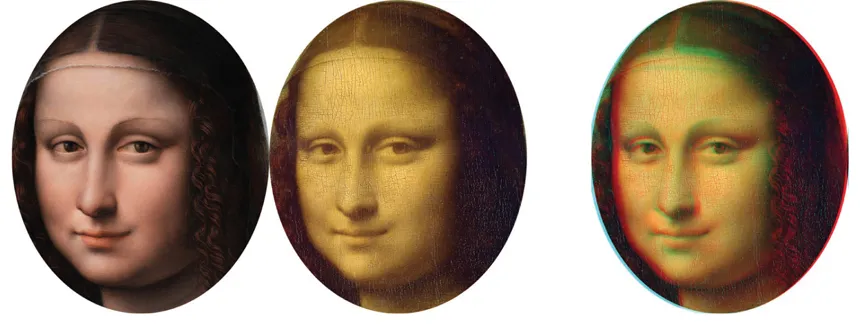Leonardo da Vinci may have invented 3-D image with ‘Mona Lisa’

A copy of the Mona Lisa in the Prado Museum (left) is painted from a slightly different perspective than the original in the Louvre (right). Together, the paintings make a stereoscopic image — whether da Vinci knew that or not.
C.-C. Carbon et al/Perception 2013
- More than 2 years ago
Leonardo da Vinci was, to put it mildly, a smart guy. He was an inventor and scientist as well as an artist, and he took a special interest in finding ways to realistically render three-dimensional forms on a flat canvas. And now, a pair of researchers say that in the early 1500s he might have created the world’s first 3-D image.
Even more surprising: It’s the Mona Lisa.
Or to be more exact, it’s both the Mona Lisa you know, in the Louvre, and a copy housed in the Prado Museum in Madrid. Researchers in Germany argue that the Prado version was painted in da Vinci’s studio at the same time, from a slightly different position. The distance between the two perspectives is very close to the distance between a person’s eyes, creating a stereoscopic 3-D effect when the two are combined.
“This points to the possibility that the two [paintings] together might represent the first stereoscopic image in world history,” the researchers wrote in their initial report on the phenomenon last year in Perception.
The team has followed up with further study of the paintings, to be published in the journal Leonardo, that uses the perspective shift to suggest that the paintings’ mountainous background was painted on a flat canvas and hung behind the subject, like a background in a modern portrait studio.
The Prado painting was long considered unremarkable, just one of many anonymous copies later made of the original Mona Lisa, known as La Joconde in French and La Gioconda in Italian. Da Vinci painted the original portrait of Lisa Gherardini, wife of Francesco del Giocondo, in the early 1500s. The Prado copy’s background was black, and it was coated in heavy varnish. In 2012, the Louvre requested the copy for display at an exhibition and asked a Prado researcher if it had ever been studied. The researcher looked at the painting under an infrared camera and discovered that underneath the black paint was the same background as in the original, a hilly landscape. The black paint has now been removed, and further imaging has revealed layers with the same changes and corrections made to the original. It appears that the two paintings may have been painted at the same time, in the same place, both artists tweaking the work in the same ways.
If true, differences in the two paintings indicate the Prado version was probably painted by a student, a practice fairly common in Leonardo’s studio.
To re-create the positions of the artists in the two-artist scenario, Claus-Christian Carbon and Vera Hesslinger of the University of Bamberg in Germany calculated perspective differences by comparing landmarks such as the tip of the nose in the two versions. They also had 32 people visually estimate the artists’ positions relative to the subject while looking at each painting. The researchers mapped out the artist positions that would result in the slightly different view seen in the paintings, and then made a tiny reference version of that scene in the greatest use of minifigures ever:

The re-creation has da Vinci standing to the right of the other artist, and a little farther from the subject. “They did not stand just side to side. This would have changed the perspective dramatically, because a body is about 60 centimeters wide,” Carbon says. “So the first person stands a little to the side but also a little bit more ahead of the other,” Carbon says. This setup would have minimized the perspective distance between the artists.
The horizontal distance between the perspectives worked out to 69 millimeters, pretty close to the average distance between an Italian man’s eyes, or interocular distance, of 64 millimeters.
And this, it turns out, is exactly how 3-D images are made. Our brains perceive depth by combining the images from each of our eyes, which each see a scene from a slightly different perspective. (This is why covering one eye hampers depth perception.) So looking at two pictures that differ in perspective by the interocular difference can create a stereoscopic, or 3-D, image.
One way to see the 3-D effect is to look at two stereoscopic images side by side with the field of view of each eye crossed in front of you. You might remember the kids’ books that have two images that you hold right in front of your eyes and then slowly pull back while practicing a thousand-yard stare until, pop! The two images merge into one 3-D picture.
To see the two Mona Lisas in 3-D, the same principle would apply. The paintings would be viewed side-by-side with the viewer’s eyes converged in front of them (or with the eyes looking farther apart, a similar technique called parallel viewing).
The two images can also be tinted red and cyan and then viewed through old-school red-and-blue 3-D glasses to get the same effect. The researchers tinted electronic versions of the two paintings, and voila. Dig out some 3-D glasses for this one (plus see more here on Carbon’s website).

“It is ‘wow,’” Carbon says. “And this is 330 years before the first stereogram was invented,” says Carbon. In 1838, British scientist Charles Wheatstone invented a stereoscope that used mirrors to combine the left-eye and right-eye views of a drawing into a 3-D scene.
DaVinci did write about monocular and binocular vision, and studied aspects of optics including eye anatomy and light reflection, and he even experimented with colored light sources. But it’s not clear whether he put all the pieces together to understand how to create a stereoscopic image. The paintings don’t quite make a perfect stereo pair, the researchers say, but a good one for being 500-year-old paintings.
To begin with, not all experts accept that the Prado painting was made simultaneously alongside the original, and da Vinci’s writings don’t explicitly describe a stereoscopy experiment like that suggested by Carbon and Hesslinger. “Any study should be founded historically on Leonardo’s knowledge of parallax and his discussions of binocular vision in relation to representation,” says Martin Kemp, an Oxford University expert on da Vinci who has written extensively about artists’ historical use of perspective.
“Whether this quality was actually created by intention or by accident can, of course, not be said for sure,” Carbon and Hesslinger write. “But in the case of Leonardo, you never know.”
Follow me on Twitter: @GoryErika







